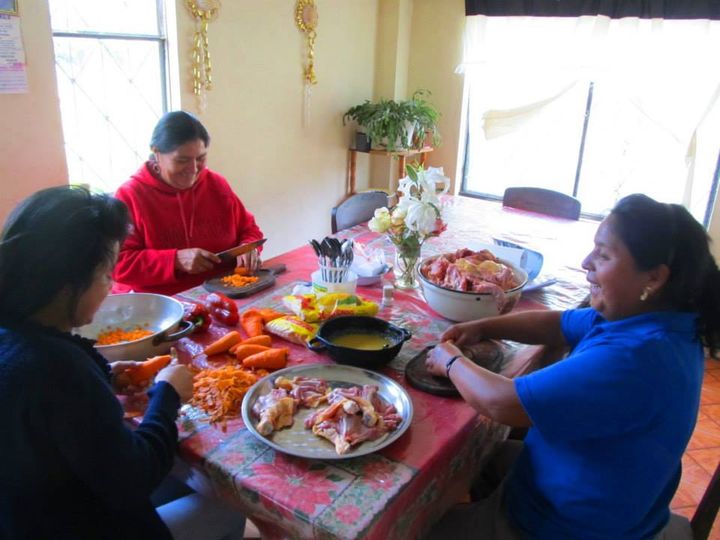This post was written by Global Citizen Year Alum Madeline Lisaius

The rain veils my hair with sparkling beads, and big droplets born of shielding leaves splash my face. It is cool for the first time since I arrived in Keweriono, a remote Waorani community in the Ecuadorian Amazon, and I have gone wandering. It is with childlike wonder that I have set out not long after dawn to walk the trail along the Shiripuno river, dipping machete-roughened hands into clear streams, tracing tracks of tapir in the cool red clay, and admiring the tiny jewels of water suspended on the webs of unseen orb weavers. Although almost seven thousand kilometers away from my first home, I feel at ease in my misty shroud.
And like a mistaken ring of a tambourine in a meditative symphony of raindrops, I hear shifting leaves to my left. Silent and watching is a meñe (jaguar), only twenty meters away in the forest. And I am afraid. The type of stomach-dropping, air-stealing fear that comes when feeling death all of a sudden in your shadow. I was not only childish in my curiosity, I was likewise so in my safety. No one knows where I am, I have neither machete nor knife, and I am utterly alone. Had I been stalked, there is no way for me to know. But from growing up in the Pacific Northwest of the United States, I have a dash of experience with apex predators - albeit bears and mountain lions - and I step back, feeling for stable footing through my heavy rubber boots. I step back again, and then again, and I am soon out of sight of that big cat. And I turn, and I travel fast back along the river until I am once again among the snaking footpaths and home of Keweriono. The fear subsides much faster than the adrenaline, which lingers on as I describe the encounter many times under many roofs with many bowls of chicha in hand as I travel through the community. I am safe from the meñe once more.
This is not the first time I have experienced this fear. There are moments that still resurface in dreams and in a dark wandering mind - a stalking predator but of human form, the slow cinching of illness without hope of aid, and routes corrected just barely in time. And there are also moments that are curious in retrospect. One comes from my first year living in Ecuador, when I was a Global Citizen Year Fellow living in a rolling Andean highland agricultural community. For many months I was afraid to go to sleep. A different type of fear than my jaguar encounter to be fair - rather, it was of the variety of haunting dread. Each night I lay dreaming under the thick blankets necessary to keep warm, fleas came. Sometimes in the couples and sometimes in the dozens, leaving red welts across my body. The fleas and their bites wore my resolve and mental fortitude, a straw that almost broke the camel’s back time and time again.

Maddy with her host family in Cuenca, Ecuador during her Global Citizen Year.
Growing up in the states, there was always a “fix” - I learned as a baby that controlling and minimizing discomfort is not only possible, it is also expected. Friends’ families had ‘fixed’ fleas that a cat or dog had brought home, and so I thought I could do the same. And it was with that belief that I attempted many times (and failed) to end my flea problem - a saturday spent sitting in the sun guarding my many blankets from the flea-full dogs and cats in the hope that sun would banish my nighttime visitors, coating said blankets with salt later in the hopes the fleas would rub themselves to death after the sun treatment failed, nights spent with a facemask sleeping under those blankets now fumigated, and later the cult-like ring of flea collars I slept within. My host family had no flea problem, so my crusade remained a private one fueled by internet searches on flea treatments. And yet I write today, four years later, with over a thousand bites - the work of sandflies, chiggers, ants, mosquitos and the like - with little more than nagging itch.
In retrospect, I see that it was the many months of sitting in my flea bite discomfort and eventually accepting that there would be an indeterminate period without a ‘fix’ that has made the difference between my flea problem and my current bug bite situation; the flea problem was actually a me problem. My fear was not one of going to sleep or of the fleas, but of losing the control I believed I should have been able to maintain over my discomforts. It has raised its ugly head as avoiding social events where I don’t know many people, hesitance in pushing my outdoor experience, and even being afraid to come back to Ecuador. The list of other learned fears I have come to recognize in myself are that of failing, of deviation, of standing up against dominant powers, of vulnerability - the list goes on.

Making tamales in Ecuador.
Reflecting on my jaguar encounter, I am reminded that these are not the things I want to spend my life being afraid of. I am certifiably not an expert on the Learning and Internalization of Fear, but I am trying to spend my lifetime building a fear-full habit, of welcoming certain learned fears with the hope that they will fade like flea bites did and my variety bites will. As part of that habit building, I travel across Waorani territory to understand how people in places like Keweriono communicate concerns about the forest and to explore the discrepancies between what they mean and what a western science perspective would expect from what they said. In fact, the basis of my current work is a personal failure that I am working to embrace. Two years ago, when I was back in Ecuador working with the Waorani Women’s Association (AMWAE) to evaluate their cacao program, folks across the territory - from communities just four hours in car from the hub city of Puyo to communities reachable by four hours in a car, seven hours in a canoe and two hours walking - vocalized ‘deforestación’ as a primary concern. But returning to Stanford after that summer research, I measured forest cover change over the past decade using satellite imagery and found almost none, no ‘deforestación,’ in the territory. I perceived a discrepancy between what people said and what was measurable; in reality, the discrepancy was between what I heard and understood and what was measurable.
I am finding that people use “deforestación” to describe the many ways that the forest is becoming less their forest and unlike the home they knew as children, a de-foresting of the home forest. This takes the forms of pollution, extractive industry, population pressure both within and outside of the territory, over-harvesting of resources and cultural loss. And the removal of some trees, but not what I was taught that deforestation should be. I am finding that I imposed my western science language onto what I was told back in 2015 when I failed to listen to and understand the narratives of the regional forest experts - a mistake that I am worried that influential actors working in social and environmental spheres are also making. Thanks to two Stanford families and National Geographic Society, I am spending this year digging into that mistake with the intent of translating between the expert lived experiences of changes to the landscape and the western scientific community. I aspire to spend my life serving people in fringe places who are underserved by government and science, and my work now is one step of battling the fears that prevent me from doing that job to the best of my ability. I am sitting in my fears that my best is not enough, that I will grow distant from my friends in the States when I do work abroad, that my mentors will be disappointed. I hope that with time, encounters with meñe, jaguar, continue to be what brings me fear. Not failure, not rejection, not loss of control, not of deviation. Undeniably a lifelong joy of (un)learning fear.

Madeline Lisaius grew up in Seattle spending her weekends hiking, kayaking and mushroom hunting across the Cascade and Olympic mountains. She took a gap year after high school with Global Citizen Year to live and work in Ecuador, and there she found her passion for the natural landscape and its intimate relationship with human well-being. Afterwards, she started at Stanford University where she is pursuing both Bachelor and Master of Science degrees in Earth Systems. Since her gap year, Madeline has returned to Ecuador to work with indigenous women of the Amazon on a small-agriculture program and has also worked using satellite imagery to promote food security in India, Tanzania, Uganda, and Kenya. Madeline is currently in Ecuador during her second gap year with support from Stanford and National Geographic researching the experience of deforestation alongside her partner, the Waorani Women's Associacion (AMWAE).
